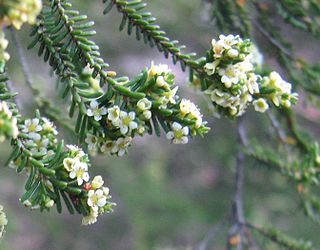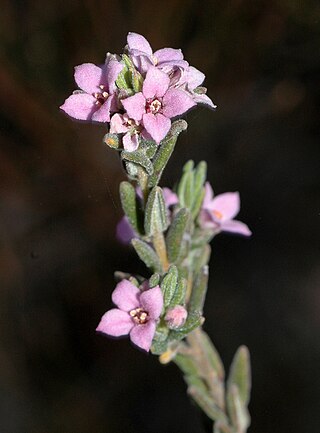
Pseudanthus is a genus of nine species of flowering plants in the family Picrodendraceae, and is endemic to Australia. Plants in the genus Pseudanthus are small, heath-like, monoecious shrubs with simple, leathery leaves, and flowers arranged in upper leaf axils, male flowers usually with three or six stamens and female flowers with three styles.

Hibbertia, commonly known as guinea flowers, is a genus of flowering plants in the family Dilleniaceae. They are usually shrubs with simple leaves and usually yellow flowers with five sepals and five petals. There are about 400 species, most of which occur in Australia but a few species occur in New Guinea, New Caledonia, Fiji and Madagascar.

Ricinocarpos is a genus of evergreen flowering plants in the family Euphorbiaceae and is endemic to Australia. Plants in the genus Ricinocarpos are monoecious shrubs with leaves arranged alternately along the branches, the edges curved downwards or rolled under. Male flowers are arranged singly or in racemes at the ends of branchlets, with four to six sepals that are fused at the base. There are four to six petals that are longer than the sepals, with many stamens fused to form a central column. Female flowers are arranged singly and are similar to male flowers but with three styles fused at the base and with a deeply branched tip. The fruit is a capsule containing seeds with an elaiosome.

Micromyrtus is a genus of flowering plants in the family Myrtaceae and is endemic to Australia. Plants in the genus Micromyrtus are shrubs with simple leaves arranged in opposite pairs, and white, pink or yellow flowers arranged in upper leaf axils, the flowers with five sepals five petals and five or ten stamens.

Verticordia brownii, commonly known as pink brownii or pink cauliflower is a flowering plant in the myrtle family, Myrtaceae, and is endemic to the south-west of Western Australia. It has small, neatly arranged, oval leaves and heads of pale pink to magenta or white flowers. It was one of the first verticordias to be collected, although it was not initially known by that name. The collection was made by Robert Brown on the Bass and Flinders circumnavigation of the Australian mainland on HMS Investigator.

Verticordia plumosa, commonly known as plumed featherflower, is a flowering plant in the myrtle family, Myrtaceae and is endemic to the south-west of Western Australia. It was the first species in the genus to be described, although initially given the name Chamelaucium plumosum. It is a shrub with linear leaves and rounded groups of scented pink, mauve or white flowers. Two varieties of this species have been declared as being "threatened".

Verticordia is a genus of more than 100 species of plants commonly known as featherflowers, in the myrtle family, Myrtaceae. They range in form from very small shrubs such as V. verticordina to trees like V. cunninghamii, some spindly, others dense and bushy, but the majority are woody shrubs up to 2.0 m (7 ft) tall. The flowers are variously described as "feathery", "woolly" or "hairy" and are found in most colours except blue. They often appear to be in rounded groups or spikes but in fact are always single, each flower borne on a separate stalk in a leaf axil. Each flower has five sepals and five petals all of a similar size with the sepals often having feathery or hairy lobes. There are usually ten stamens alternating with variously shaped staminodes. The style is simple, usually not extending beyond the petals and often has hairs near the tip. All but two species are found in Southwest Australia, the other two occurring in the Northern Territory.

Thryptomene micrantha, commonly known as ribbed thryptomene, is a species of flowering plant in the family Myrtaceae and is endemic to south-eastern Australia. It is a spreading to erect shrub with egg-shaped leaves, the narrower end towards the base, and white flowers with five petals and five stamens.

Micrantheum serpentinum, the western tridentbush, is a species of shrub or small tree in the family Picrodendraceae, endemic to Tasmania.

Ricinocarpos pinifolius, commonly known as wedding bush, is a shrub of the family Euphorbiaceae and is endemic to eastern Australia. It has fragrant daisy-like flowers in spring.

Styphelia adscendens, commonly known as golden heath, is a species of flowering plant in the heath family Ericaceae and is endemic to south-eastern Australia. It is a prostrate or low-lying shrub with lance-shaped leaves and cream-coloured, pale yellowish-green or reddish flowers arranged singly or in paris in leaf axils.

Hibbertia fasciculata is a species of flowering plant in the family Dilleniaceae and is endemic to south-eastern Australia. It is a small erect to spreading shrub with glabrous stems except on new growth, narrow linear leaves, and yellow flowers arranged in leaf axils, with eight to twelve stamens surrounding three carpels.

Leptospermum continentale, commonly known as prickly tea-tree, is a species of slender, straggling shrub that is endemic to south-eastern Australia. It has sharp-pointed, narrowly egg-shaped leaves, white flowers arranged singly in leaf axils and woody fruit that remains on the plant when mature.

Leucopogon ericoides, commonly known as the pink beard-heath, is a species of flowering plant in the heath family Ericaceae and is endemic to south-eastern Australia. It is a slender shrub with oblong leaves, and white to pinkish, tube-shaped flowers.

Zieria veronicea, commonly known as the pink zieria, is a plant in the citrus family Rutaceae and is endemic to south-eastern Australia. It is a small, lemon-scented shrub densely covered with velvety hairs. Up to three flowers with four pink petals appear in leaf axils in late spring.
Hibbertia acrotrichion is a species of flowering plant in the family Dilleniaceae and is endemic to a restricted area of Western Australia. It is a small, erect shrub with linear, cylindrical leaves and yellow flowers arranged singly in leaf axils with eleven stamens arranged in groups.

Diplolaena dampieri, commonly known as Dampier's rose, is a species of flowering plant in the family Rutaceae. It is endemic to the west coast of Western Australia. It has slightly leathery, oblong-elliptic shaped leaves, hairy bracts and pale red to orange flowers from July to September.

Hibbertia acicularis, commonly known as prickly guinea-flower, is a species of flowering plant in the family Dilleniaceae and is endemic to eastern Australia. It is an erect or prostrate shrub with linear to lance-shaped leaves and yellow flowers arranged singly in leaf axils with the six to eight stamens joined at the base, in a single cluster.
Hibbertia hirsuta is a species of flowering plant in the family Dilleniaceae and is endemic to southern Australia. It is a small, slender, prostrate shrub with sparsely hairy foliage, narrow elliptic leaves and small yellow flowers with a single petal, usually only a single stamen and two carpels.

Condylocarpon guyanense is a species of plant in the Apocynaceae family. It is native to Brazil, French Guiana, and Guyana. René Louiche Desfontaines, the botanist who first formally described the species, named it after Guyana where Joseph Martin collected the specimen he examined.

















